Related Research Articles
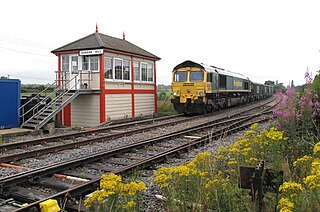
On a rail transport system, signalling control is the process by which control is exercised over train movements by way of railway signals and block systems to ensure that trains operate safely, over the correct route and to the proper timetable. Signalling control was originally exercised via a decentralised network of control points that were known by a variety of names including signal box, interlocking tower and signal cabin. Currently these decentralised systems are being consolidated into wide scale signalling centres or dispatch offices. Whatever the form, signalling control provides an interface between the human signal operator and the lineside signalling equipment. The technical apparatus used to control switches (points), signals and block systems is called interlocking.

The Quintinshill rail disaster was a multi-train rail crash which occurred on 22 May 1915 outside the Quintinshill signal box near Gretna Green in Dumfriesshire, Scotland. It resulted in the deaths of over 200 people and remains the worst rail disaster in British history.
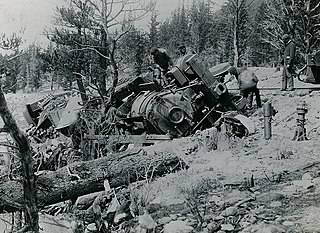
In rail transport, a derailment is a type of train wreck that occurs when a rail vehicle such as a train comes off its rails. Although many derailments are minor, all result in temporary disruption of the proper operation of the railway system and they are a potentially serious hazard.

In railway signalling, an interlocking is an arrangement of signal apparatus that prevents conflicting movements through an arrangement of tracks such as junctions or crossings. In North America, a set of signalling appliances and tracks interlocked together are sometimes collectively referred to as an interlocking plant or just as an interlocking. An interlocking system is designed so that it is impossible to display a signal to proceed unless the route to be used is proven safe.

The Clapham Junction rail crash occurred on the morning of 12 December 1988, when a crowded British Rail passenger train crashed into the rear of another train that had stopped at a signal just south of Clapham Junction railway station in London, England, and subsequently sideswiped an empty train travelling in the opposite direction. A total of 35 people died in the collision, while 484 were injured.
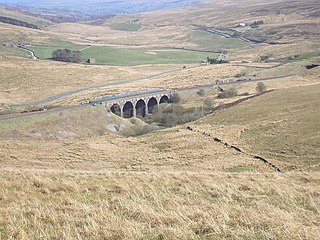
The Hawes Junction rail crash occurred at 5.49 am on 24 December 1910, just north of Lunds Viaduct between Hawes Junction and Aisgill on the Midland Railway's Settle and Carlisle main line in the North Riding of Yorkshire, England. It was caused when a busy signalman, Alfred Sutton, forgot about a pair of light engines waiting at his down (northbound) starting signal to return to their shed at Carlisle. They were still waiting there when the signalman set the road for the down Scotch express. When the signal cleared, the light engines set off in front of the express into the same block section. Since the light engines were travelling at low speed from a stand at Hawes Junction, and the following express was travelling at high speed, a collision was inevitable. The express caught the light engines just after Moorcock Tunnel near Aisgill summit in Mallerstang and was almost wholly derailed.

The Abermule train collision was a head-on collision which occurred at Abermule, Montgomeryshire, Wales on Wednesday 26 January 1921, killing 17 people. The crash arose from misunderstandings between staff which effectively over-rode the safe operation of the Electric Train Tablet system protecting the single line. A train departed carrying the wrong tablet for the section it was entering and collided with a train coming the other way.
The Winwick rail crash took place at Winwick Junction, near Warrington on the London, Midland and Scottish Railway, on 28 September 1934. Two trains collided, resulting in 11 deaths and 19 injured.

The Clayton Tunnel rail crash occurred on Sunday 25 August 1861, five miles (8 km) from Brighton on the south coast of England. At the time it was the worst accident on the British railway system. A train ran into the back of another inside the tunnel, killing 23 and injuring 176 passengers.
Two rail accidents have occurred near Castlecary, Scotland. One of these was in 1937 and one in 1968. Both events involved rear-end collisions, and caused the deaths of 35 and 2 people respectively.
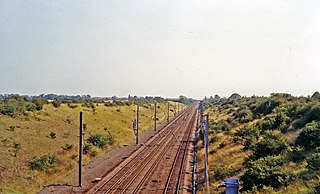
The Abbots Ripton rail disaster occurred on 21 January 1876 at Abbots Ripton, then in the county of Huntingdonshire, England, on the Great Northern Railway main line, previously thought to be exemplary for railway safety. In the accident, the Special Scotch Express train from Edinburgh to London was involved in a collision, during a blizzard, with a coal train. An express travelling in the other direction then ran into the wreckage. The initial accident was caused by:

Mechanical railway signalling installations rely on lever frames for their operation to interlock the signals, track locks and points to allow the safe operation of trains in the area the signals control. Usually located in the signal box, the levers are operated either by the signalman or the pointsman.
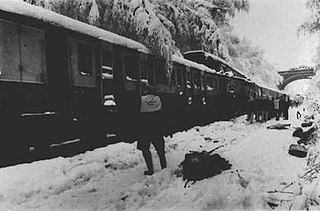
The Seer Green rail crash occurred on the morning of 11 December 1981 near Seer Green, Buckinghamshire, England between two four-car Class 115 diesel multiple units, killing one driver and three passengers.
The Wrawby Junction rail crash was a train crash which occurred on 9 December 1983, at Wrawby Junction, near Barnetby station, North Lincolnshire, England.
The Battersea Park rail crash occurred on 2 April 1937, just south of Battersea Park railway station on the Southern Railway, in London, England. Two electrically driven passenger trains collided on the Up Local line; the second train, from Coulsdon North to Victoria, had been allowed into the section while it was still occupied by the first train, from London Bridge to Victoria. The signalman at Battersea Park, G. F. Childs, believing there was a fault with the Sykes electromechanical interlocking apparatus which was installed at the box, had opened up the case of the instrument and inadvertently cleared the interlock which should have prevented this situation. The official enquiry ruled that he subsequently accepted the Coulsdon train, although he should have been aware that the London Bridge train had not cleared the section. Ten people were killed, including the guard of the London Bridge train, and eighty people were injured, seven sustaining serious injuries. Another accident had occurred at Battersea Park in 1881.
The Lichfield rail crash was a rail crash which occurred on New Year's Day 1946 at Lichfield Trent Valley station in Staffordshire, England. 20 people were killed in the accident, caused when a points failure routed a goods train into the back of a stationary passenger train waiting at the station. This event, alongside the Abbots Ripton rail accident, is the basis for the story The Flying Kipper in the Railway Series by Rev. W. Awdry.
The Kirtlebridge rail crash took place in 1872 at Kirtlebridge railway station in Dumfriesshire. An express passenger train ran into a goods train that was shunting; 11 people lost their lives immediately, and one further person succumbed later. The cause was a failure to communicate between the station master in charge of the shunting operation, and the signalman. There was not full interlocking of the points, and the block system of signalling was not in use.

The Signals, Crane and Subway are heritage-listed railway infrastructure at Charters Towers railway station, Enterprise Road, Charters Towers, Charters Towers Region, Queensland, Australia. They were added to the Queensland Heritage Register on 30 October 2008.
References
- ↑ "RAILWAYS (ACCIDENT, CONINGTON) (Hansard, 6 March 1967)". api.parliament.uk. Retrieved 28 December 2023.
- ↑ McNaughton 1969, p3.
- ↑ "On This Day March 6, 1967". 28 December 2023. ISSN 0140-0460 . Retrieved 28 December 2023.
- ↑ McNaughton 1969, p7.
- ↑ McNaughton 1969, p8.
- ↑ McNaughton 1969, p9.
- 1 2 McNaughton 1969, p.10